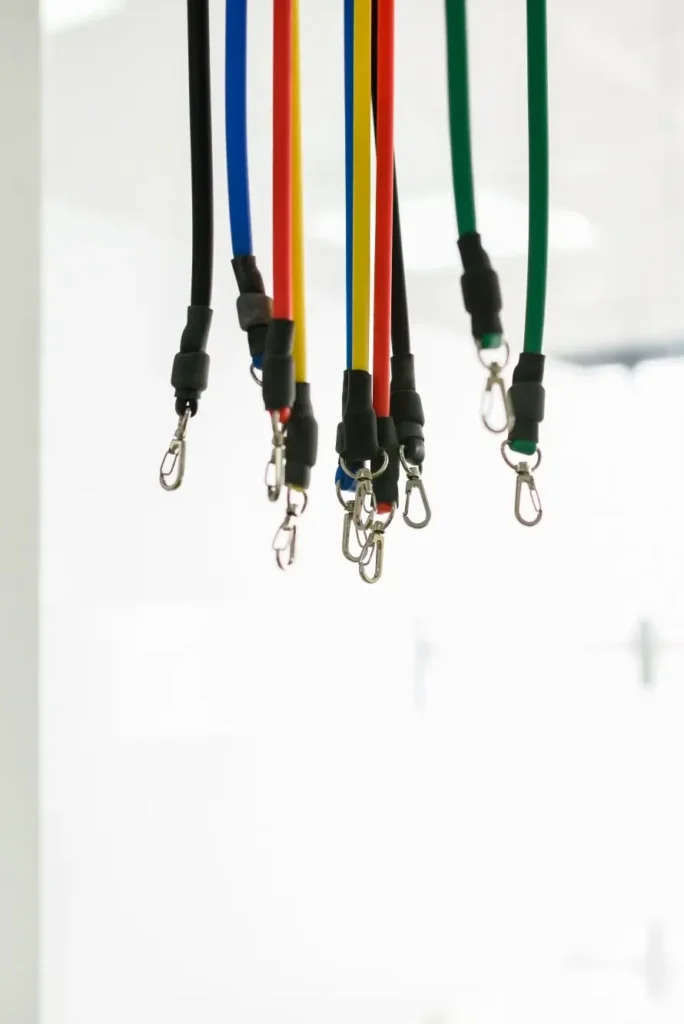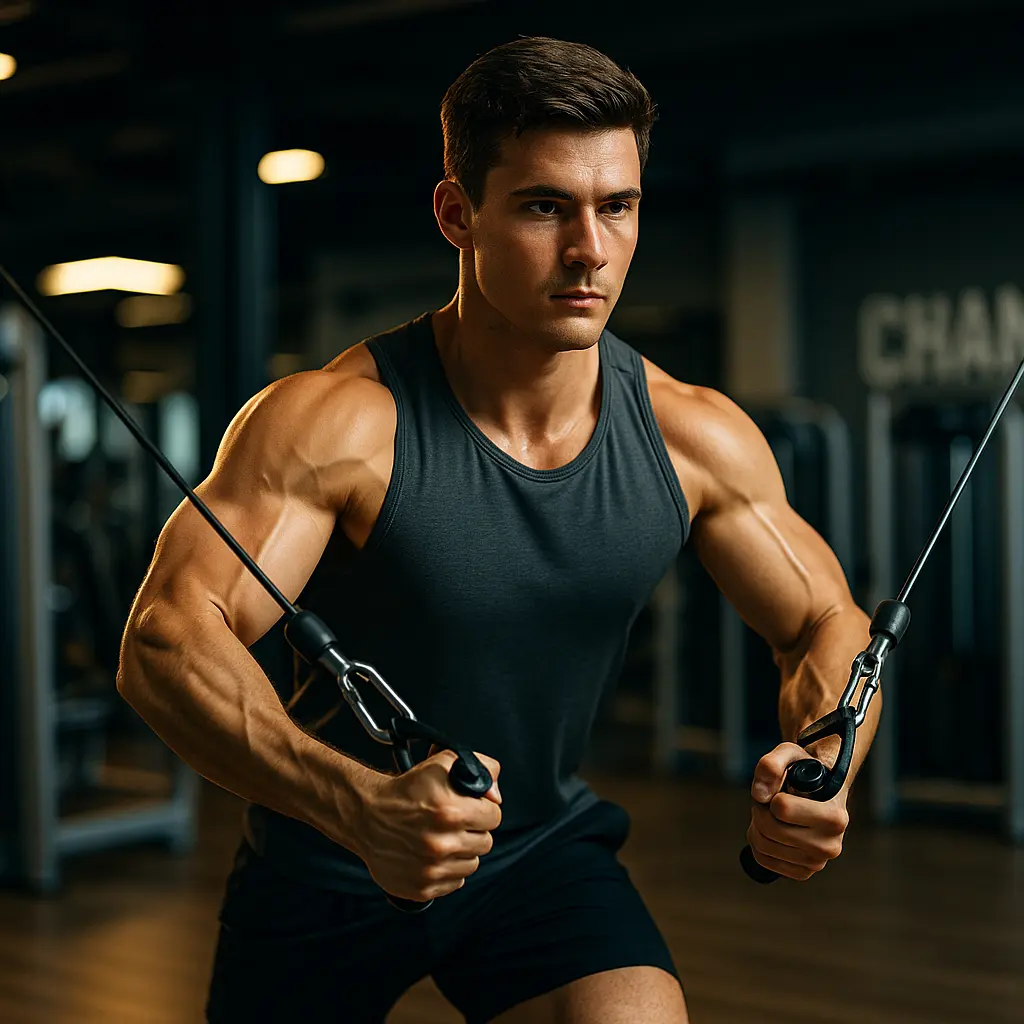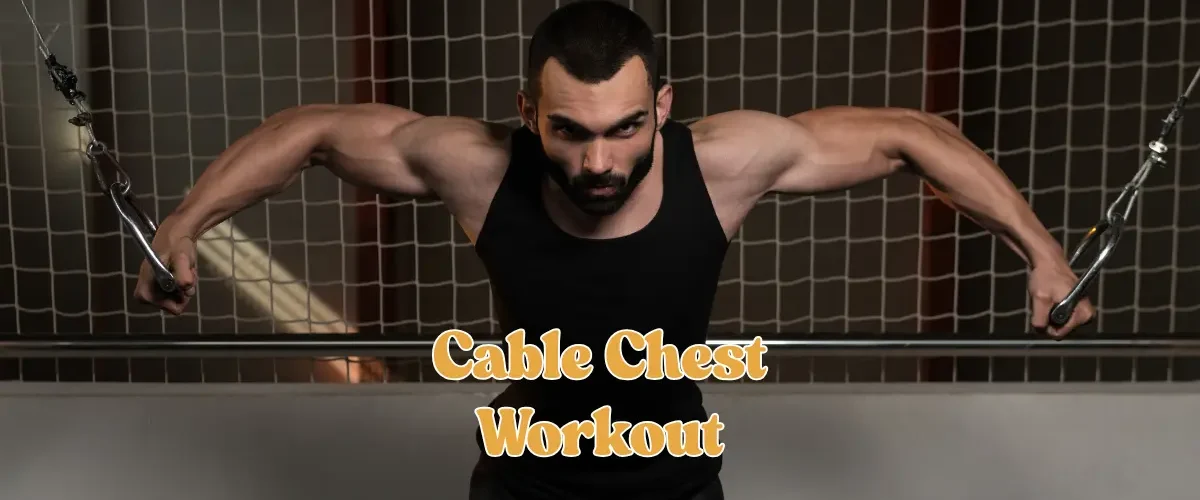Your Moment With the Cables: An Emotional Kick-Off (cable chest workout)
You click the carabiners into place and feel the subtle pull of the weight stack before you even step away from the tower. It’s not the clang of metal plates that fires you up—it’s the promise of total control. With cables, every millimeter of the range is yours to command. No fixed bar path, no uneven spotter assistance, no ego-inflating bounce off the chest. Just unbroken tension that follows the exact track your body sets.
If you’ve hit that maddening bench-press plateau or noticed your left pec lagging slightly behind your right, a cable-focused chest workout is the equilibrium shift you’ve been missing. Today, you’ll learn exactly how to turn those sliding pulleys into a sculptor’s chisel—carving shape, symmetry, and raw strength you can feel under your T-shirt and see in the mirror.
Why Cable Chest Workouts Outshine the Classics


Constant Tension Equals Constant Gains
Unlike free weights, cables never let your muscles “rest” at the top or bottom of a rep. Continuous tension:
- Extends time under load (TUL) for deeper hypertrophy signals.
- Forces stabilizer muscles to fire the entire set, not just at sticking points.
- Eliminates inertia cheating—each rep is honest work.
Personalized Biomechanics for Pain-Free Pressing
Shoulder pinch? Elbow ache? With cables you can:
- Adjust the line of pull to match your shoulder mobility.
- Modify hand spacing mid-set without re-racking weight.
- Align handles independently so each pec handles its own workload—perfect for ironing out strength imbalances.
Versatility Without Equipment Hoarding
On cable chest workout One dual-pulley station covers presses, flyes, crossovers, drop sets, and functional sport-specific patterns—all inside a single footprint. That means:
- Shorter gym sessions (no waiting for benches).
- Zero excuse travel workouts if your hotel gym has even a basic cable tower.
- Easy progressive overload simply by moving the pulley height or adding micro-plates.

Chest Anatomy 101: Know the Muscles You’re Targeting, cable chest workout
| Muscle | Function in Chest Movements | Why Cables Help |
|---|---|---|
| Pectoralis Major – Clavicular Head (Upper Chest) | Flexes humerus upward (think incline press) | Low-to-high cable fly keeps constant tension throughout the arc |
| Pectoralis Major – Sternal Head (Mid / Lower Chest) | Brings arms toward midline (classic press) | Mid-height cables mirror natural press path, reducing joint stress |
| Pectoralis Minor | Scapular protraction, rib elevation | Cable presses teach proper scapular movement, limiting subacromial pinching |
| Serratus Anterior | Pulls scapula forward & around ribcage | Single-arm cable presses demand core rotation, lighting up serratus |
| Anterior Deltoid & Triceps | Secondary movers | Variable angles let you emphasize chest, not shoulders or triceps |
Pro tip: Visualize fiber direction while you train—upper fibers run diagonally, so raise the handles; lower fibers run down and in, so drive the handles downward.
Gear Checklist: Dial In Your Station Before Lifting (cable chest workout)
- Dual Adjustable Pulley Machine – smooth tracks and easy height changes.
- Single D-Handle Attachments – essential for unilateral symmetry work.
- Short Straight Bar or EZ-Bar – perfect for heavy standing cable presses.
- Ankle Straps (Optional) – surprisingly effective for low-cable fly variations.
- Micro-Plates or Pin-Magnets – enable 2–3 kg jumps when 5 kg is too steep.
- Towel & Chalk – sweaty hands ruin tension; a quick dusting keeps grip solid.
Five-Minute Dynamic Warm-Up
| Movement | Reps | Purpose |
|---|---|---|
| Arm Circles (forward/back) | 20 each | Lubricate shoulder joint |
| Banded Pull-Apart | 15 | Prime posterior chain for better posture |
| Scapular Push-Up | 10 | Activate serratus & core |
| Cable Fly Rehearsal @ 50 % Working Weight | 12 | Groove motor pattern |
Spend no more than five focused minutes here—you’re prepping, not fatiguing.
The Core Cable Chest Moves (cable chest workout)
Below you’ll find seven proven exercises. Plug them into the routine templates later or cherry-pick to patch weak spots.
1. Low-to-High Cable Fly (Upper Chest Builder)
Setup & Execution
- Position both pulleys at the machine’s lowest notch.
- Grab the D-handles, step forward into a staggered stance, and align fists near hips.
- With a slight bend in the elbows, sweep the handles upward toward eye level.
- Squeeze the pecs hard, pause one count, then lower under control for three counts.
Coaching Cues
- “Hug a big tree” to keep elbows fixed.
- Keep ribs tucked—flaring cheats tension onto delts.
Programming
- Sets: 3
- Reps: 10–12
- Intensity: 1–2 reps in reserve (RIR)
2. Standing Cable Chest workout Press
Why It Rocks
You mimic a push motion you actually use in life—throwing, blocking, or shoving—while letting scapulae move freely, sparing shoulders.
Execution Tips
- Pulleys at mid-chest height.
- One foot forward, core braced.
- Drive handles forward and slightly together.
- Don’t lock elbows; keep soft bend to protect joints.
3. Single-Arm Fly With Core Rotation
Perfect for ironing out asymmetry and lighting your serratus.
- Anchor just one handle.
- Stand sideways, cable in outside hand.
- Sweep arm across body while letting trunk rotate subtly.
- Sets/Reps: 3 × 12 each side.
4. High-to-Low Cable Fly (Lower Chest Emphasis)
- Pulleys above shoulder height.
- Bring handles down toward pockets.
- Two-second squeeze at bottom for maximal lower-pec recruitment.
5. Cable Hex Press
Hold two handles together (or use a short straight bar). Press out while actively squeezing hands inward. Tension spikes through the inner chest, forging that coveted mid-line valley.
6. Cable Floor Press
Lie supine, knees bent. Press handles from floor to lockout. Floor limits elbow travel, helping lifters with shoulder irritation still hammer the pecs.
7. Cable Crossover Finisher
Classic burnout move: moderate weight, high reps (15–20), continuous tension until pecs feel molten.
Plug-and-Play Workout Templates (cable chest workout)
Choose the track that fits your schedule and experience. Rotate every 6–8 weeks.
Beginner Push Day (30 Minutes)
| Exercise | Sets | Reps | Rest |
|---|---|---|---|
| Standing Cable Press | 3 | 10 | 60 s |
| Low-to-High Fly | 3 | 12 | 45 s |
| Cable Push-Up (feet on floor) | 2 | AMRAP | 60 s |
- Progression: Add one rep per set each week or bump weight 2.5 kg when reps exceed target by two.
Intermediate Hypertrophy Blast (45 Minutes)
- Superset A
- High-to-Low Fly – 3 × 12
- Push-Up (feet elevated) – 3 × AMRAP
- Standing Cable Press – 4 × 8 (2-second eccentric)
- Single-Arm Fly With Rotation – 3 × 15 each side
- Crossover Dropset – 1 giant set: reduce weight 20 % × three drops, no rest
Advanced Upper/Lower Split Add-On (20-Minute Chest Focus) / cable chest workout
| Move | Sets | Reps | Tempo |
|---|---|---|---|
| Cable Hex Press | 4 | 6 | 3-1-1-0 |
| Med-Ball Chest Pass (contrast) | 4 | 8 | Explosive |
| Cable Floor Press | 3 | 8 | 2-0-2-0 |
Rest 90 s between paired moves to maximize power output.
Fuel Your Gains: Performance Nutrition
Training triggers adaptation; nutrition cements it. Use these quick recipes to hit macros without fuss.
High-Protein Strawberry-Oats Shake (Pre-Workout)
| Ingredient | Amount | Calories | Protein |
|---|---|---|---|
| Rolled oats | 40 g | 150 | 5 g |
| Whey isolate | 30 g | 120 | 25 g |
| Frozen strawberries | 100 g | 35 | 0.7 g |
| Almond milk (unsweet.) | 250 ml | 30 | 1 g |
Why it works: Low fat for faster digestion, slow-burn carbs plus quick-hit protein to sustain effort.
Chicken-Quinoa Power Bowl (Post-Workout)
| Ingredient | Amount | Calories | Protein |
|---|---|---|---|
| Grilled chicken breast | 150 g | 248 | 46 g |
| Cooked quinoa | 150 g | 222 | 8 g |
| Avocado | ½ fruit | 120 | 1.5 g |
| Roasted bell peppers | 80 g | 25 | 1 g |
Why it works: Complete proteins, complex carbs, and healthy fats restore glycogen, kick-start tissue repair, and steady hormones.
Meal timing tip: Aim to refuel within 60 minutes of the final set for optimal recovery.
Common Form Pitfalls & Fast Fixes
| Mistake | What You Feel | Quick Fix |
|---|---|---|
| Elbows locked straight on flyes | Elbow strain, anterior delt overload | Maintain gentle bend (“soft arms”) throughout |
| Allowing cables to yank you backward | Loss of balance, core disengaged | Stagger stance, brace abs, lean slightly forward |
| Heaving weight with momentum | Pec barely working, shoulder discomfort | Slow the eccentric to three counts, lighter load |
| Rib cage flaring on presses | Lower back ache | Exhale on exertion, keep ribs tucked |
FAQs About Cable Chest Workouts
Q1. Can a cable chest workout replace the bench press entirely?
A: Absolutely. Because cables maintain tension across the whole arc and allow varied angles, you can fully stimulate all chest fibers without ever touching a barbell. For overall strength balance, pair cables with body-weight push-ups and overhead pressing.Q2. How often should you train your chest with cables?
A: Two focused sessions per week with at least 48 hours between hits the sweet spot for growth while avoiding over-training.Q3. What starting weight should you choose?
A: Pick a load where you finish your target reps but could still squeeze out one or two more with pristine form. That “reps in reserve” buffer keeps joints safe and progress steady.Q4. Will cables help fix uneven pec development?
A: Yes. Unilateral flyes and presses force each side to carry its own load, teaching lagging fibers to catch up quickly.Q5. Do you need specialty attachments?
A: A pair of basic D-handles does 90 % of the job. Straight bars, ropes, or ankle straps simply add variety once the fundamentals feel solid.Conclusion: Clip In, Level Up on Cable Chest Workouts
You now own the blueprint for a cable chest workout that does more than pump you up for an hour—it builds a chest that stands tall the other 23. Every section you’ve read is a brick in that wall: the science-backed rationale, the anatomy primers, the exercise tutorials, and the nutrition playbook.
our Three-Step Action Plan for Cable Chest Workouts
- Schedule it: Pick two chest days in your current split and pencil in one of the templates above.
- Track it: Log weights, reps, rest, and how each angle feels. Cable training is as much about mind-muscle connection as load progression.
- Share it: Post a sweaty selfie, tag your workout buddy, and challenge them to beat your total volume. Friendly rivalry fuels results.
Remember, the cables don’t care how much you bench or how many followers you have. They only respond to consistent tension, clean form, and unapologetic effort. Clip in, breathe deep, and let every controlled rep move you closer to the powerful, balanced chest you deserve.



One Response